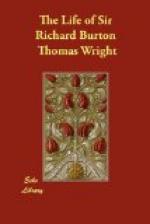Writing to Payne, 15th January, 1883, Burton says, “Has Arbuthnot sent you his Vatsyayana?[FN#401] He and I and the Printer have started a Hindu Kama Shastra (Ars Amoris Society). It will make the Brit(ish) Pub(lis) stare. Please encourage him.” Later Arbuthnot, in reply to a question put to him by a friend, said that the Society consisted practically of himself, Sir Richard Burton and the late Lord Houghton.[FN#402]
Chapter XXVI The Ananga Ranga or Lila Shastra
Bibliography:
70. The Book of the Sword. 1884.
116. The Ananga Ranga.[FN#403]
The title page of the second book, the Ananga Ranga, which was issued in 1885, was as follows:
Ananga Ranga
(Stage of the Bodiless One)
or
the Hindu art of love
(Ars Amoris Indica)
Translated from the Sanskrit
and annotated
by
A. F. F. and B. F. R.
Cosmopoli MDCCCLXXXV, for the Kama Shastra Society of London and Benares, and for private circulation only.
Dedicated to that small portion of the British Public which takes enlightened interest in studying the manners and customs of the olden East.
We are told that this book was written about 1450 by the arch-poet Kalyana Mull,[FN#404] that lithographed copies have been printed by hundreds of thousands, that the book is in the hands of almost every one “throughout the nearer East,” and also that it is “an ethnological treasure, which tells us as much of Hindu human nature as The Thousand Nights and a Night of Arab manners and customs in the cinquecento.” In India the book is known as the Kama Shastra or Lila Shastra, the Scripture of Play or Amorous Sport. The author says quaintly, “It is true that no joy in the world of mortals can compare with that derived from the knowledge of the Creator. Second, however, and subordinate only to his are the satisfaction and pleasure arising from the possession of a beautiful woman.”
“From the days of Sotades and Ovid,” says the writer of the Preface, who is certainly Burton, “to our own time, Western authors have treated the subject either jocularly or with a tendency to hymn the joys of immorality, and the gospel of debauchery. The Indian author has taken the opposite view, and it is impossible not to admire the delicacy with which he has handled an exceedingly difficult theme. ....Feeling convinced that monogamy is a happier state than polygamy, he would save the married couple from the monotony and satiety which follow possession, by varying their pleasures in every conceivable way and by supplying them with the means of being psychically pure and physically pleasant to each other.”
There is a reference to this work in Burton’s Vikram and the Vampire, where we read:[FN#405] “As regards the neutral state, that poet was not happy in his ideas who sang,




